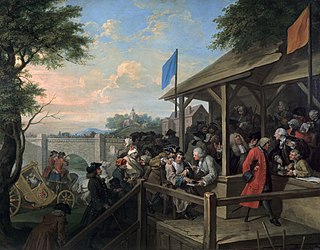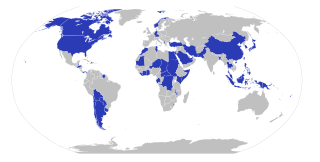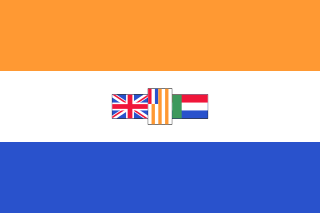An anthem is a musical composition of celebration, usually used as a symbol for a distinct group, particularly the national anthems of countries. Originally, and in music theory and religious contexts, it also refers more particularly to short sacred choral work and still more particularly to a specific form of liturgical music. In this sense, its use began ca. 1550 in English-speaking churches; it uses English language words, in contrast to the originally Roman Catholic 'motet' which sets a Latin text.

The flag of Europe or the European flag is an official symbol used by the Council of Europe (CoE) – the regional organisation representing Europe, as well as the European Union (EU), the union of 27 states. It consists of a circle of twelve five-pointed golden stars on a blue field.

A flag is a piece of fabric with a distinctive design and colours. It is used as a symbol, a signalling device, or for decoration. The term flag is also used to refer to the graphic design employed, and flags have evolved into a general tool for rudimentary signalling and identification, especially in environments where communication is challenging. The study of flags is known as "vexillology" from the Latin vexillum, meaning "flag" or "banner".

Scholar Xiao Congrong pointed out that no matter how the concept of the national flag changes, its essence has not changed - the "symbolic flag" for identifying identity. The meanings of identity, politics and military behind the symbol are all ways of use explored by people in practice according to purpose and communication. Because the national flag essentially shows the identification symbol of a political power in the form of a flag, sometimes there are more than one "symbol flag" that can represent the political power, and they can even replace each other without special provisions, which leads to some countries or political powers using other flags instead of the national flag in actual use.

Red is the color at the long wavelength end of the visible spectrum of light, next to orange and opposite violet. It has a dominant wavelength of approximately 625–740 nanometres. It is a primary color in the RGB color model and a secondary color in the CMYK color model, and is the complementary color of cyan. Reds range from the brilliant yellow-tinged scarlet and vermillion to bluish-red crimson, and vary in shade from the pale red pink to the dark red burgundy.

The Union of South Africa was the historical predecessor to the present-day Republic of South Africa. It came into existence on 31 May 1910 with the unification of the Cape, the Natal, the Transvaal, and the Orange River colonies. It included the territories that were formerly a part of the South African Republic and the Orange Free State.

The Union Jack, or Union Flag, is the de facto national flag of the United Kingdom. Though no law has been passed officially making the Union Jack the national flag of the United Kingdom, it has effectively become the national flag through precedent. The flag has official status in Canada, by parliamentary resolution, where it is known as the Royal Union Flag. As they are localities within the British state, or realm, it is the national flag of all of the British overseas territories, although local flags have also been authorised for most, which may be flown in place of, or along with the national flag. Governors of British Overseas Territories have their own flags, which are the Union flag with the distinguishing arms of the colony at the centre. The Union Flag also appears in the canton of the flags of several nations and territories that are former British possessions or dominions, as well as that of Hawaii. The claim that the term Union Jack properly refers only to naval usage has been disputed, following historical investigations by the Flag Institute in 2013.

An ensign is the national flag flown on a vessel to indicate nationality. The ensign is the largest flag, generally flown at the stern (rear) of the ship while in port. The naval ensign, used on warships, may be different from the civil ensign or the yacht ensign. Large versions of naval ensigns called battle ensigns are used when a warship goes into battle. The ensign differs from the jack, which is flown from a jackstaff at the bow of a vessel.

The flag of Norway is red with an indigo blue Scandinavian cross fimbriated in white that extends to the edges of the flag; the vertical part of the cross is shifted to the hoist side in the style of the Dannebrog, the flag of Denmark.

Pan-Africancolours is a term that may refer to two different sets of colors:

Political colours are colours used to represent a political ideology, movement or party, either officially or unofficially. It is the intersection of colour symbolism and political symbolism.

The 1980 Summer Olympics boycott was one part of a number of actions initiated by the United States to protest against the Soviet invasion of Afghanistan. The Soviet Union, which hosted the 1980 Summer Olympics in Moscow, and its allies later boycotted the 1984 Summer Olympics in Los Angeles.

This is a list of international, national and subnational flags used in Europe.

This is a gallery of international and national flags used in Asia.

The African Union (AU) is a continental union consisting of 55 member states located on the continent of Africa. The AU was announced in the Sirte Declaration in Sirte, Libya, on 9 September 1999, calling for the establishment of the African Union. The bloc was founded on 26 May 2001 in Addis Ababa, Ethiopia, and launched on 9 July 2002 in Durban, South Africa.
The African Union is a geo-political entity covering the entirety of the African continent. Its origin dates back to the First Congress of Independent African States, held in Accra, Ghana, from 15 to 22 April 1958. The conference aimed at forming the Africa Day to mark the liberation movement, each year, regarding the willingness of the African people to free themselves from foreign dictatorship, as well as subsequent attempts to unite Africa, including the Organisation of African Unity (OAU), which was established on 25 May 1963, and the African Economic Community in 1981. Critics argued that the OAU in particular did little to protect the rights and liberties of African citizens from their own political leaders, often dubbing it the "Dictators' Club".

The European Union (EU) uses a number of symbols, including the Flag of Europe, Anthem of Europe, Motto of the European Union and Europe Day.
In parliamentary systems and presidential systems of government, primary legislation and secondary legislation, the latter also called delegated legislation or subordinate legislation, are two forms of law, created respectively by the legislative and executive branches of government. Primary legislation generally consists of statutes, also known as 'acts', that set out broad outlines and principles, but delegate specific authority to an executive branch to make more specific laws under the aegis of the principal act. The executive branch can then issue secondary legislation, creating legally enforceable regulations and the procedures for implementing them.

The flag of South Africa from 1928 to 1994 was originally used by the Union of South Africa from 1928 to 1961 and later the Republic of South Africa until 1994. It was also used in South West Africa until 1990 when the territory was under South African rule. Based on the Dutch Prince's Flag, it contained the flag of the United Kingdom, the flag of the Orange Free State and the flag of the South African Republic in the centre. A nickname for the flag was Oranje, Blanje, Blou.

The Western Union (WU) was a military alliance established between France, the United Kingdom and the three Benelux countries between 1948 and 1954. The flag of the Western Union, also referred to as the Western Union Standard, displays an unbroken chain of five rectangular links in the shape of an upside-down pentagon on a blue field, with a multicoloured border taken from the WU member states' flags.
















